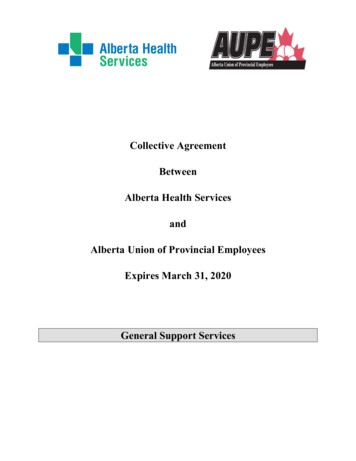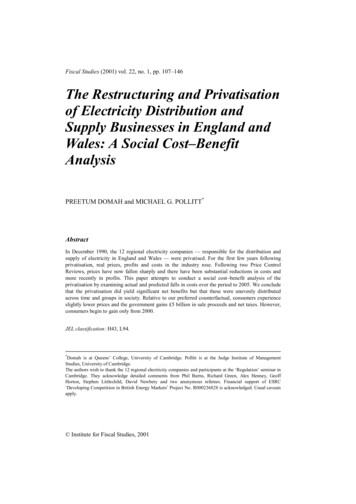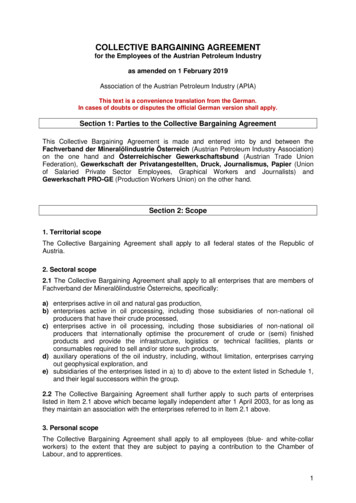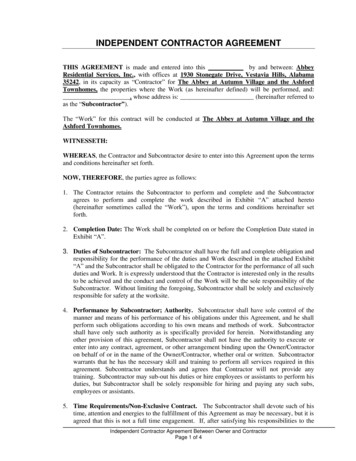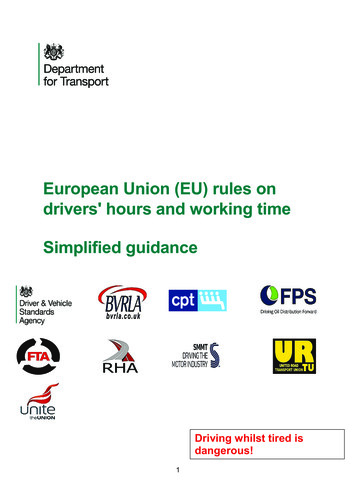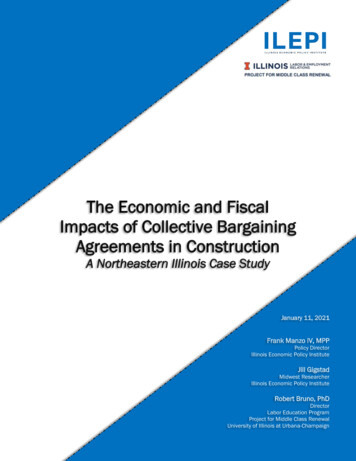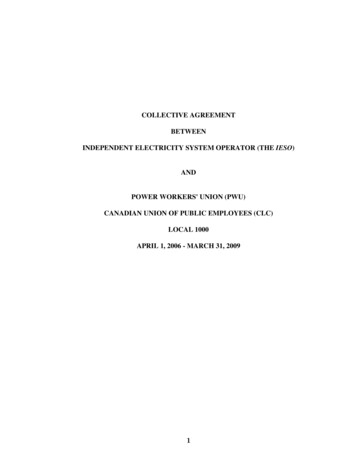
Transcription
COLLECTIVE AGREEMENTBETWEENINDEPENDENT ELECTRICITY SYSTEM OPERATOR (THE IESO)ANDPOWER WORKERS' UNION (PWU)CANADIAN UNION OF PUBLIC EMPLOYEES (CLC)LOCAL 1000APRIL 1, 2006 - MARCH 31, 20091
TABLE OF CONTENTSPartTitlePagesArticles (Salmon)3--1456463AGeneral Items (Green)BMaintenance Trades (Yellow)146-170DClerical/Technical (Pink)171-191AppendixList of SupplementaryDocuments192 193(for access to these documents contact the Human Resources offices or thePWU representative)NOTEIn order to readily identify collective bargaining changes in thisAgreement from the previous one, and certain Project One changes, newchanges are printed bold and in italics. Note that certain foreign wordsused within the text are, by convention, also printed in italics, howeverthese words are easily identifiable and should not cause confusion.2
TABLE OF CONTENTSARTICLESFOUNDATION AGREEMENTARTICLE 1RECOGNITION/COLLECTIVE BARGAINING UNITARTICLE 2GRIEVANCE PROCEDUREARTICLE 2ADISCIPLINE AND DISCHARGEARTICLE 3ARBITRATIONARTICLE 4WORKING CONDITIONS/MID TERM AGREEMENTSARTICLE 5UNION SECURITY/UNION DUESARTICLE 5ASECURITY GUARDS - CONFLICTWITHDRAWAL OF SERVICESARTICLE 6NO DISCRIMINATIONARTICLE 7MANAGERIAL RIGHTS OF THE IESOARTICLE 8JOB CLASSIFICATION AND WAGE RATESARTICLE 9SPECIFIC MATTERS OF AGREEMENT/NEW ENDEAVOURSARTICLE 10SELECTION TO VACANCIESARTICLE 11SURPLUS STAFF PROCEDUREARTICLE 12PURCHASED SERVICES AGREEMENTARTICLE 13EMPLOYMENT SECURITY PLANARTICLE 14EMPLOYMENT SECURITY AND WORKASSIGNMENTARTICLE 15SUCCESSOR RIGHTSARTICLE 16DURATION OF THE AGREEMENT3OFINTERESTAND
COLLECTIVE AGREEMENTBETWEENINDEPENDENT ELECTRICITY SYSTEM OPERATOR (The IESO)andPOWER WORKERS' UNION (PWU), CANADIAN UNION OF PUBLICEMPLOYEES, Local 1000 - CLC, hereinafter referred to as the "Union" which executesthis Agreement by M. Hyatt, M. Forrest, G. Faba and I. Pooni, who have been dulyappointed for the purpose, in accordance with the constitution of the Union.WHEREAS the Union has requested the IESO to enter into a Collective Agreement andthe IESO has consented thereto:NOW THIS AGREEMENT WITNESSETH that there shall be three parts, namely, Part'A' - General Items, Part 'B' - Maintenance Trades, and Part 'D' - Clerical/Technical. It isalso witnessed that the IESO and the Union agree each with the other as follows:Foundation AgreementThe Independent Electricity System Operator and the Power Workers' Union arecommitted to making the IESO a successful corporation and recognize that businesssuccess ultimately depends on the ability to create and operate a marketplace forelectricity that continuously satisfies market participants and stakeholders. There is anunderstanding that a focus on meeting customer needs and ensuring the IESO'sreputation for independence, integrity, and business conduct will not only ensure thesuccess and viability of the enterprise, but will also create meaningful work, employeesatisfaction and security.Principles:The IESO and PWU will work together towards business success in a safe and healthywork environment where employees are encouraged to participate in the operation of thebusiness according to the following principles:Communications will be open, honest, timely and expressed in a professionalbusiness like manner.Management decisions will consider the needs of the customer, the business,employees and the community.Management will consult with employees and employee representatives and shareinformation through open, honest communications.4
Process:The IESO and PWU will be proactive in resolving issues using a problem solvingapproach. This will be implemented through a Steering Committee of seniorrepresentatives of management and PWU whose role is to manage and lead by:Establishing sub-committees and selecting resources for these; the parties willselect their respective members in consultation with each other.Setting specific performance expectations and overseeing the results.Projects:1.Article 11 modificationsThe parties agree to jointly develop new Article 11 language that reflects principlesoutlined in this Memorandum. This project will be completed within one year ofratification.2.Job Evaluation PlanThe parties agree to jointly develop a Job Evaluation Plan that reflects the needs of theIESO within the current business environment and recognizes the speed with which jobsevolve. This includes ensuring compliance with applicable Pay Equity legislation. Thisproject will be completed during the term of this agreement.The FASC will meet to review and discuss the status of the following on an as requiredbasis:The IESO Pension Plan(a)(b)(c)(d)(e)Monitor the IESO's administration of the Pension Plan as established under theElectricity Act, 1998 and other applicable legislation.Make recommendations respecting the administration of the Pension Plan.Promote awareness and understanding of the Pension Plan on the part of Planmembers.Review the IESO's approved annual financial statements and investmentperformance.Review the IESO's approved Actuarial Valuations of the Pension Plan and discussthe need for assumption changes.5
General IssuesDiscuss and/or resolve issues associated with the following processes:(A)(B)(C)(D)(E)Long Term DisabilityWSIBSick LeaveEHB issues e.g., alternative treatments, existing drug formulary etc.Career opportunities including an assessment of the potential for higher rated jobsand new classifications within the PWU. The IESO will assess the trainingand re-skilling of regular employees in view of the IESO’s evolving businessdirection and technological change. This will be discussed at FASC no laterthan October 1, 2006. On an annual basis, the IESO will discuss adevelopmental plan with each employee. This plan will consider therequirements of the IESO and the skill/competency developmental needs ofthe individual employee.ARTICLE 1RECOGNITIONCOLLECTIVE BARGAINING UNIT1.11.2The IESO recognizes the Union as the sole bargaining agent for all regular,part-time and temporary employees1 and security employees but excluding:(a)Employees now represented by other bargaining agents.(b)Persons above the rank of working supervisor.(c)Persons who exercise managerial functions in accordance with the OntarioLabour Relations Act.(d)Persons employed in a confidential capacity in matters relating to labourrelations in accordance with the Ontario Labour Relations Act.When an employee is removed from normal duties to act in a vacated position orrelieve for an incumbent or perform a temporary assignment, the following shallapply:(a)1When the length of time involved is known to be three months or less, theemployee will retain his/her present jurisdictional status."Employees" are employees pursuant to the Labour Relations Act for Ontario SO, 1995, c.1 Schedule A, as amended.6
(b)(c)When it is expected that the length of time will be longer than threemonths, the employee will be excluded or included at the commencementof his/her new responsibilities. However, in the event the period isactually less than three months:(1)in exclusion cases, the Union will be reimbursed the dues whichwould have been paid;(2)in inclusion cases, the Union will reimburse the employee the dueswhich have been paid.When the length of time is unknown, the employee will retain his/herpresent jurisdictional status up to the three month period. If the periodextends beyond three months, the employee will then be either included orexcluded.ARTICLE 2GRIEVANCE PROCEDURE2.1It is mutually agreed by the parties hereto that it is the spirit and intent of thisAgreement to address grievances promptly. Therefore, any employee covered bythis Agreement having a grievance may present such grievance to therepresentative of the Union appointed by the Union for that purpose. The Unionrepresentative may then proceed to have such grievance addressed in accordancewith the following steps established hereby for the purpose of addressinggrievances.2.2This procedure shall also apply to Union concerns regarding the adequacy of jobdocuments and/or the rating, for jobs covered by the Clerical-Technical JobEvaluation Plan disputes arising from Article 8, and OGL disputes.2.3Any allegation that an employee has been subjected to unfair treatment or anydispute arising out of the content of this Agreement shall be understood to be afit matter for the following grievance procedure. All matters of grievance by anyemployee or group or class of employees for whom the Union is the bargainingagent and which the Union may desire to present shall be dealt with inaccordance with the following procedure.2.4GrievancesGrievances are to be filed within thirty (30) days from the date that the grievor knew orshould have known the facts giving rise to the grievance. The IESO is to reply in writingwithin seven (7) days.Steps in grievance process: Non-disciplinary matters:7
2.5Step 1Within seven (7) days of reply or time limited for reply, a meeting withcontact supervisor.Step 2If Step 1 meeting not held or if grievance not resolved at Step 1, grievancesgo to next scheduled meeting of Grievance Review Board.Grievance Review BoardThe Grievance Review Board shall consist of two Union representatives (at a high level)and two Management representatives (at a high level), who will have the authority toagree unanimously to a final and binding settlement of any grievance or unanimouslyagree to the scheduling of any grievance.Grievance Review Board meetings are to be scheduled regularly as agreed to by theparties or ordered by the Chief Arbitrator in all work locations. The purpose of theGrievance Review Board will be to attempt to settle all cases, failing which the GrievanceReview Board will agree to facts where possible and ensure that all documentary andother evidence is disclosed by the parties.If not resolved at the Grievance Review Board, grievances moveto arbitration.2.6Disciplinary Matters2.6.1Prior to the imposition of any disciplinary penalty, the IESOshall hold a Disciplinary Interview, which shall replace Step 1 of the grievanceprocess.2.6.2The IESO shall provide the Union and any employees who may be disciplinedthree (3) days' notice of the Interview.2.6.3The Interview shall take place between the IESO, the Unionand the accused individual.2.6.4The IESO shall set out its allegations and except where the allegations couldconstitute a criminal offence, the Union or the individual(s) shall set out theirversion of the events. Minutes, but not a transcript, of the Interview setting outthe substance of the discussion shall be taken.2.6.5The minutes of the meeting shall be provided to the Union and the accusedindividual(s) within seven (7) days of the Interview.2.6.6The Union and the accused individual(s) shall forward a written reply to theminutes, if any, within seven (7) days of receipt of the minutes.2.6.7Should the IESO choose to impose discipline, the Union has ten (10) days to filea grievance commencing at Step 2.8
2.6.8Nothing in the disciplinary interview process is intended to interfere with theIESO's right to investigate matters.2.7Facilities and Costs2.7.1The IESO shall provide the necessary facilities for all meetings in the grievanceprocess.2.7.2Maintenance of normal earnings and payment of expenses shall be provided bythe IESO for all Union representatives on a grievance committee.2.7.3The fees of all arbitrators and costs associated with arbitration hearings shall beshared equally by the parties, subject to current practices.ARTICLE 2ADISCIPLINE AND DISCHARGE2A.1Any allegation that an employee has been demoted, suspended, discharged orotherwise disciplined without just cause shall be a fit matter for the grievanceand arbitration procedures as provided for in this Collective Agreement.2A.2When disciplining or discharging probationary employees for just cause, it isrecognized that the probationary period is an extension of the selection processand that they have short service. Therefore, the threshold for discipline anddischarge may be less than that of a regular employee in similar circumstances.2A.3Disciplinary penalties resulting in a suspension without pay will not be imposeduntil a final decision, (agreement between Union and Management, or anarbitrator's judgment) has been reached.2A.4Unless otherwise agreed to, after a letter(s) of reprimand has been on anemployee's file for a maximum of two years, and there have been no furtheroccurrences, then the letter(s) of reprimand will be removed from all files.9
2A.5Disciplinary PenaltiesA copy of all letters of employee reprimand shall be sent to the chief steward,except in cases where in the IESO's opinion the matter involved is of aconfidential nature. In the latter instance, the letter will state that the Unionhas not received a copy of the letter.This shall not prevent a supervisor from taking on-the-job disciplinary actionincluding immediate suspension subject to later confirmation.ARTICLE 3ARBITRATION3.0THE ARBITRATION PROCESSThe arbitration process will continue on the basis of the practice currently adhered to bythe parties, but any disputes relating to such practice or any requests for changes in thepractice may be referred to the Chief Arbitrator, or Deputy Chief Arbitrator as referred toherein, for a ruling.3.1This procedure shall not apply to Union allegations of unfair treatment.3.2Where a difference arises between the parties relating to the interpretation,application, or administration of this Agreement, including any question as towhether a matter is arbitrable, or where an allegation is made that thisAgreement has been violated, either of the parties may, after exhausting anygrievance procedure established by this Agreement, notify the other party inwriting of its desire to submit the difference or allegation to arbitration.3.3Unless the parties agree to a Board of Arbitration, the Chief Arbitrator or theDeputy Chief Arbitrator so order, all grievances shall be submitted to SinglePanel Arbitration.3.4Chief Arbitrator and Deputy Chief ArbitratorFor the duration of this collective agreement, Martin Teplitsky shall serve as the ChiefArbitrator. The Chief Arbitrator will have exclusive, final and binding authority over allissues relating to the scheduling of cases, including decisions as to who hears which caseand when it is heard and shall have the power to relieve against time limits, includingthose in the grievance process and the referral to arbitration in respect of all cases.10
3.5All ArbitratorsAll arbitrators are to determine their own procedure, may admit evidence that would notbe admissible in court and may rely on such evidence to render a decision. All arbitratorswill have the power and authority to determine the real issues in dispute between theparties in any particular case and to relieve against time limits in the grievance process.All arbitrators' decisions will be final and binding. All arbitrators shall have the power tomake interim relief orders.3.63.7Principles of Single Panel Arbitration(a)Arbitrators shall decide up to fifteen (15) grievances each day. The casesshall be heard on an expedited basis after the parties have exchanged theirwritten briefs. Oral evidence may be called only where the arbitratordeems necessary and only with leave of the arbitrator.(b)The decisions are precedent setting and shall be accompanied by reasonson any non-factual issues.(c)The parties may use the services of counsel.Powers of the Chief Arbitrator in the Single Panel ProcessThe Chief Arbitrator, in consultation with the parties, will have the power to:1.2.3.appoint arbitrators;assign grievances for resolution;schedule hearing dates in consultation with the parties.Any of the Chief Arbitrator's powers may be delegated to the Deputy ChiefArbitrator.3.8Board of ArbitrationA Board of Arbitration shall consist of an IESO nominee, a PWU nominee, and anArbitrator. A party requesting that a grievance be heard by a Board of Arbitration shall doso in writing to the other party within 10 days of the date the GRB referred the grievanceto arbitration.3.8.1NomineesOnce either party notifies the other party that an unresolved grievance will be referred toarbitration, such notice shall contain the name of the first party's nominee to anarbitration board.11
The recipient of the notice shall within 10 days, if he/she consents to the grievance beingheard by a Board of Arbitration, advise the other party of the name of its appointee to thearbitration board.3.8.2ArbitratorIf the parties agree that a Board of Arbitration should hear a grievance but fail to agreeupon a chairperson within the time limited, an appointment shall be made by the ChiefArbitrator, or, if the Chief Arbitrator is incapable of doing so, through the facilities of theOntario Labour Management Arbitration Commission or the Minister of Labour, upon therequest of either party. The Arbitration Board shall hear and determine the difference orallegation and shall issue a decision and the decision shall be final and binding upon theparties and upon any employee affected by it. The decision of a majority shall be thedecision of the Board of Arbitration, but if there is no majority, the decision of thechairperson shall govern. However, in no event shall the Board of Arbitration have thepower to change, alter, modify or amend any provision of this Agreement.3.8.3Powers of the Chief Arbitrator in the Board of Arbitration Process:(a)To determine the hours within which arbitrations are conducted.(b)To assist in reducing the cost, and reducing the delay and increasing theefficiency of the arbitration process.ARTICLE 4WORKING CONDITIONS/MID-TERM AGREEMENTS4.1Working conditions during the term of this Agreement shall be as outlined inthis Agreement and Mid-Term Agreements except such Mid-Term Agreementsas are agreed obsolete by the parties.In addition, the general environmental privileges surrounding an employee shallalso be considered as working conditions. These privileges would include suchthings as wash-up time, transportation facilities, safety appliances, generalsafety or health precautions.4.2Any modification within the confines of this Agreement shall be subject toagreement by the IESO and the Union's executive. Changes to the undernotedsubjects, however, can be made with the written agreement of the Chief Stewardwith the exception as noted in 4.2 (e) and may be cancelled by either party uponthe giving of 30 days' notice:(a)Changes in working hours between the hours of 7:00 am to 6:00 pm for anindividual, work group or crew.(b)The extension of acting positions beyond 90 days as outlined in Part 'B',Section 10.0; and Part 'D', Section 4.2.12
4.3(c)Modifications to hours of work (specific) at all locations for banked timearrangements.(d)Local extensions to a maximum of three months beyond the normal 15accumulated months (in which there have been no breaks in employmentexceeding five months) on the use of temporary employees to meet shortterm staffing requirements without invoking regular-seasonal status.(e)Arrangements allowing flexibility for employees assigned to temporarywork headquarters subject to PWU Sector Vice-President approval.Mid-Term AgreementsA mid-term agreement is a modification of the Collective Agreement executed bythe parties on the prescribed form (a specimen of which is shown below) duringthe term of the Collective Agreement.Unless specifically referred to in a Mid-Term Agreement the pertinentprovisions of the Collective Agreements shall apply.(SAMPLE)MID-TERM AGREEMENTTITLENumberDateIt is jointly agreed that the following Mid-Term Agreement shall form part of theCollective Agreement between the parties:THE IESOUNION13
ARTICLE 5UNION SECURITY/UNION DUES5.1All employees covered by this Agreement who are members of the Union on thedate hereof shall, as a condition of employment, maintain such membership.5.2Employees who are not members on the date hereof but who become members ofthe Union subsequent to said date shall as a condition of employment, maintaintheir membership thereafter.5.3New employees shall, as a condition of employment, be or become members ofthe Union within 15 days of their engagement and shall, as a condition ofemployment, maintain their membership thereafter.5.4Membership as a condition of employment as specified in 5.1, 5.2 and 5.3 shallnot apply while membership is withheld or suspended, or where a member isexpelled by the Union.5.5In all cases for employees in the Collective Bargaining Unit as defined in Article1, the IESO shall be responsible for the signing of dues authorizations and shalldeduct from the weekly wages of each employee, an amount equal to the weeklyunion dues in effect at the time and shall transmit the monies so deducted to theSecretary-Treasurer of the Union at the times designated by the Union.5.6The Company will supply the local Chief Steward with an up to date listing of allPWU regular, temporary, part-time and regular seasonal employees monthly.5.7A Union representative will be given an opportunity to conduct an orientationsession for new probationary/regular employee(s) or temporary employees withgreater than 6 months' service within regular working hours at a time and of aduration that is mutually agreeable between the IESO and the Union. Thepurpose is to acquaint the new employee with the benefits and duties of unionmembership.5.8The IESO will not oppose any action by the Union to discipline its members asidentified in its constitution.14
ARTICLE 5ASECURITY GUARDS - CONFLICT OF INTERESTAND WITHDRAWAL OF SERVICES5A.1Conflict of InterestThe Union recognizes that the inclusion of security staff in this collectiveagreement may create the possibility of a conflict of interest between theresponsibilities to their duties and their membership in the Union. The Unionwill not impede security staff from performing any of their job duties.These provisions are intended to permit security staff to perform their dutiesunfettered and to preserve the confidentiality of their work. Security staff aresometimes required to take action with respect to other employees. It is theintent of these provisions that security guards will fulfill their dutiesirrespective of whether the other employees involved are or are not representedby PWU CUPE Local 1000. The IESO agrees that all security staff representedby PWU CUPE Local 1000 will have normal access to Union representation.The Union agrees not to pursue any internal disciplinary actions againstsecurity staff for performing their duties.Any conflict of interest involving security staff will be subject to an expeditiousinternal confidential review/resolution process. If the internal resolution processis not capable of resolving the conflict of interest, then an expeditious externalprocess will be activated.The Executive Committee of the Union clearly recognizes the unique position ofsecurity staff regarding their relationship with other PWU CUPE Local 1000represented employees and will strive to ensure that any conflict of interestwhich may arise is handled sensitively and expeditiously.5A.2Withdrawal of ServicesRecognizing the need to protect the IESO assets, employees, the public and inorder to meet regulatory requirements, the parties agree to the following:(a)The Union agrees to give the IESO twenty-one (21) calendar days' formalnotice in writing prior to any legal withdrawal of services by security staff;15
5A.3(b)The Union agrees that the IESO may use replacement workers from anynon-PWU source to perform security functions withdrawn as a result of alegal strike. Replacement workers will only perform security functionsduring the duration of the legal work stoppage;(c)PWU security staff will co-operate in the training of replacement workersand shall provide an orderly turnover to replacement workers before anywithdrawal of services. Any training of replacement workers withintwenty-one (21) calendar days prior to a legal work stoppage (i.e., duringthe notice period in (a) above) will not be subject to temporary instructionallowances provided for elsewhere in this agreement;(d)Upon request, the IESO will provide the Union with information on thenumber of replacement workers performing security functions;(e)This agreement exempts the parties from Subsections 73.2(4) to 73.2(11) ofthe Ontario Labour Relations Act R.S.O. 1990 and any amendmentsthereto of that statute.The Union agrees to communicate and educate its stewards and membership onthe intent of this Article.ARTICLE 6NO DISCRIMINATION6.1The IESO shall not discriminate against an employee because of membership oractivity in the Union or the exercise of his/her lawful rights, and any employeecovered by the Agreement who feels that he or she has suffered discriminationshall have the right to seek redress in accordance with Grievance andArbitration Procedures.6.2An employee who has a complaint with respect to discrimination in theemployment relationship, as envisioned under the Human Rights Code, willhave access to the internal Human Rights resolution process if he/she so desires.The employee, if he/she so desires, may have a Union representative present.The complaint, the Human Rights resolution process and the results of sameshall not be subject to the grievance/arbitration process.16
ARTICLE 7MANAGERIAL RIGHTS OF THE IESOThe IESO has and shall retain the exclusive right and power to manage its business anddirect its working forces including, but without restricting the generality of the foregoing,the right to hire, suspend, discharge, promote, demote, and discipline any employee. TheIESO shall exercise the said functions in accordance with the provisions of this CollectiveAgreement.ARTICLE 8JOB CLASSIFICATION AND WAGE RATESJob classification and wage rates shall be as they appear in wage schedules constitutingpart of this Agreement. The IESO shall discuss with the Union any changes to existingjob classifications and wage rates, or the introduction of new job classifications and newwage rates. Where a difference arises between the parties, the IESO may introduce thenew or amended job classification or wage rates; but either party may require that thedifference between them be submitted directly to the grievance process as detailed inArticle 2 and the decision shall be binding on both parties.ARTICLE 9SPECIFIC MATTERS OF AGREEMENT/NEW ENDEAVOURS9.1These matters are to be dealt with in accordance with Parts 'A', 'B', 'D', and TheUnion Clerical-Technical Job Evaluation Manual.New Endeavours9.2Where a new field of endeavour is undertaken by the IESO and the employeesconcerned fall within the jurisdiction of the Union by virtue of Article 1, thequestion of whether such employees will be covered by an existing part of theCollective Agreement, an existing part of the Collective Agreement with specialprovisions or modifications, or a new part of the Collective Agreement will be onefor joint agreement.17
Article 10 - Selection to VacanciesTABLE OF s to a Vacancy in the PWU-CUPE Local 1000JurisdictionRestrictions on SenioritySupervisory and Non-Supervisory SORY POSITIONSPrimary ConsiderationsSelection ProcessSupervisory Positions IncludedNo Effect on Union RepresentationPositions above the Jurisdiction of the Union10.310.3.1NON-SUPERVISORY POSITIONSSenior Qualified(a) Requisite considerations(b) Overall seniority being the governing factor(c) Selection priority(i)Clerical Technical(ii) Trades PositionsBest Qualified(a) Primary considerations(b) Positions included10.3.210.4GENERAL10.4.1Waiver of Posting10.4.2Employee Release10.4.3Employee Preference10.4.4Reasons for Non-Selections10.4.5Posting of Vacancies and Transfer Upon Appointment10.4.6Posting: Weekly Salaried10.4.7 Notification to Applicants10.4.8 Late Applications10.5DEFINITIONS10.6MOVING EXPENSES10.7TRANSITION PROVISIONS18
ARTICLE 10SELECTION TO VACANCIES10.1Vacancies10.1.1No person shall be appointed to a vacancy in the PWU - CUPE Local 1000jurisdiction until all qualified PWU - CUPE Local 1000 represented applicantshave been selected. This restriction is limited to situations involving inter-unionjurisdiction and does not apply to non-union personnel.10.1.2If an employee is appointed to a vacancy within the PWU - CUPE Local 1000jurisdiction from a bargaining unit which restricts seniority in the IESO to itsown membership, his/her seniority will be limited to service within the PWU CUPE Local 1000 bargaining unit.10.1.3In filling vacancies within the PWU - CUPE Local 1000 bargaining unit, theIESO will take into consideration whether the vacant position is supervisory ornon-supervisory. The following will apply:10.2Supervisory Positions10.2.1In considering applicants for supervisory positions, primary considerationshould not be given to seniority but to personal qualities such as leadership,reliability, judgment, ability to organize and instruct and an understanding anda display of the practice of good human relations. For supervisory positions, anendeavour will be made to select the most promising candidate.10.2.2 Only those individuals satisfactorily possessing the above characteristics, asassessed by the IESO, should be considered. Where practicable, applicants forsupervisory positions should be interviewed by the supervisor responsible for theselection. Seniority will govern only in cases where there does not appear, in theIESO's opinion, to be much difference in qualifications.10.2.3For the purpose of this article, supervisory positions will include:(a)Union Trades Supervisor - Level 3 and higher positions in the trades(b)Clerical-technical jobs which are credited with degree 3 or higher in theResponsibility for Supervision factor of the Clerical-Technical JobEvaluation Plan.10.2.4 The provisions of Article 10.2.3 above will not affect the status of incumbents forUnion representation or the future posting of vacancies as they may occur.19
1
COLLECTIVE AGREEMENT BETWEEN INDEPENDENT ELECTRICITY SYSTEM OPERATOR (The IESO) and POWER WORKERS' UNION (PWU), CANADIAN UNION OF PUBLIC EMPLOYEES, Local 1000 - CLC, hereinafter referred to as the "Union" which executes this Agreement by M. Hyatt, M. Forrest, G. Faba and I. Pooni, who have been duly appointed for the purpose, in accordance with the constitution of the Union.


